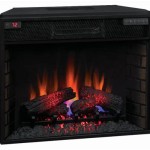What Are The Side Vents On A Fireplace For?
Fireplaces, a traditional source of warmth and ambiance, are complex systems designed with specific features to maximize efficiency and safety. Among these features, the side vents found on some fireplace models often raise questions regarding their purpose and function. These vents are not merely aesthetic additions; they play a crucial role in the fireplace's heating performance and overall operation. Understanding their function requires a deeper dive into the principles of fireplace design and heat transfer.
Modern fireplaces, especially those designed for supplemental heating, often incorporate features that go beyond the simple open hearth of the past. These features aim to increase the amount of heat radiated into the room, reduce heat loss up the chimney, and improve the overall efficiency of the combustion process. Side vents are a key component in achieving these goals, acting as conduits for airflow that enhances heat circulation and distribution.
The role of side vents is multifaceted and intricately linked to the fireplace's convection system. Unlike radiant heat, which directly warms objects in its path, convection relies on the movement of air to distribute heat throughout a space. The side vents facilitate this process, drawing in cool air, warming it within the fireplace's structure, and then expelling it back into the room.
Enhancing Convection Heating
The primary function of side vents on a fireplace is to enhance convection heating. A traditional open fireplace primarily radiates heat. While this radiant heat can be comforting to those directly in front of the fire, it is inefficient at warming the entire room. A significant portion of the heat generated by the fire escapes up the chimney, while the rest is unevenly distributed.
Fireplaces with side vents, however, are designed to capture and redistribute a substantial portion of this otherwise lost heat. The vents are strategically placed to allow cooler air from the room to enter the fireplace's outer shell. This air then circulates around the firebox, where it is heated by the hot metal surfaces. The heated air, now less dense, rises and exits through the upper vents, creating a continuous cycle of airflow.
This convection process significantly increases the fireplace's heating efficiency. Instead of relying solely on radiant heat, the fireplace actively draws in cool air, warms it, and expels it back into the room, resulting in a more even and consistent distribution of heat. This is particularly beneficial in larger rooms or homes where a single source of radiant heat would be insufficient to maintain a comfortable temperature.
The placement and design of the side vents are crucial for optimizing convection heating. The lower vents are typically located near the floor, where the coolest air is found. The upper vents are positioned higher up, allowing the heated air to rise naturally and circulate throughout the room. The size and shape of the vents are also carefully considered to ensure adequate airflow without compromising the fireplace's structural integrity or aesthetic appeal.
Furthermore, some fireplace models incorporate baffles or internal chambers within the convection system to further enhance heat transfer. These features increase the surface area of the heat exchanger, allowing the air to absorb more heat as it circulates around the firebox. This results in even warmer air being expelled from the upper vents, further improving the fireplace's heating performance.
The effectiveness of convection heating provided by side vents is also influenced by the overall design of the fireplace. A well-insulated firebox and a tightly sealed door can minimize heat loss and maximize the amount of heat available for the convection system. Regular cleaning and maintenance of the vents are also essential to ensure unrestricted airflow and optimal performance.
Reducing Heat Loss Up the Chimney
Another important function of side vents is to indirectly contribute to reducing heat loss up the chimney. While the vents themselves do not directly block the escape of hot gases, they improve the fireplace's overall efficiency, resulting in less heat being wasted and, consequently, less heat escaping through the chimney.
Traditional fireplaces are notorious for their high rate of heat loss. A significant portion of the heat generated by the fire is simply drawn up the chimney, along with combustion gases. This is due to the natural draft created by the temperature difference between the inside and outside of the chimney. This draft pulls air from the room, including the heated air from the fire, and expels it into the atmosphere.
By enhancing convection heating, side vents help to reduce the amount of heat that is drawn up the chimney. The more efficiently the fireplace can heat the room through convection, the less radiant heat is needed, and the less heat is lost up the chimney. This is because a greater proportion of the heat generated by the fire is being utilized to warm the room, rather than being wasted.
Furthermore, some fireplace designs incorporate features that further reduce heat loss up the chimney. For example, a damper can be used to restrict airflow when the fireplace is not in use, preventing warm air from escaping and cold air from entering the room. Baffles and smoke shelves can also be used to slow down the flow of combustion gases, allowing more heat to be radiated into the firebox before being exhausted up the chimney.
The combination of enhanced convection heating through side vents and features designed to reduce heat loss up the chimney results in a significantly more efficient fireplace. This not only saves energy but also reduces the amount of fuel required to heat the room, making the fireplace more environmentally friendly.
It's important to note that the effectiveness of these features in reducing heat loss depends on proper installation and maintenance. A poorly installed damper or a chimney that is not properly sealed can negate the benefits of enhanced convection heating and result in significant heat loss.
Improving Combustion Efficiency
While not their primary purpose, side vents can indirectly contribute to improving combustion efficiency in some fireplace designs. By promoting airflow around the firebox, they can help to ensure a more complete and efficient burning of the fuel.
Complete combustion requires an adequate supply of oxygen. In a traditional open fireplace, the airflow is often uneven, leading to incomplete combustion. This results in the production of smoke, soot, and other pollutants, as well as a reduction in the amount of heat generated by the fire.
Side vents can help to improve airflow around the firebox, providing a more consistent supply of oxygen to the fuel. This promotes more complete combustion, resulting in less smoke and soot, and more heat. This is particularly true in fireplaces with a closed firebox, where the airflow is more restricted.
Some fireplace models also incorporate adjustable vents that allow the user to control the amount of airflow to the fire. This can be used to fine-tune the combustion process and optimize the efficiency of the fire. By increasing the airflow, the user can promote more complete combustion and reduce the amount of smoke produced. By decreasing the airflow, the user can slow down the burning rate and conserve fuel.
The efficiency of combustion is also influenced by the type of fuel being burned. Dry, seasoned wood burns more efficiently than wet or green wood. Using the appropriate type of fuel is essential for maximizing heat output and minimizing smoke and pollution.
Furthermore, regular cleaning of the fireplace and chimney is essential for maintaining optimal combustion efficiency. A buildup of soot and creosote can restrict airflow and reduce the efficiency of the fire. It can also pose a fire hazard. Therefore, it is important to have the fireplace and chimney inspected and cleaned regularly by a qualified professional.
In summary, the side vents on a fireplace are more than just decorative features. They play a crucial role in enhancing convection heating, reducing heat loss up the chimney, and, in some cases, improving combustion efficiency. Understanding their function is essential for maximizing the performance and safety of the fireplace.
Gas Fireplace Venting Explained Heatilator

Vented Vs B Vent Direct Free Dixie S

Remove Or Cover Up Old Heatilator Vents Hearth Com Forums Home Fireplace Brick Makeover
Gas Fireplace Venting Explained Heat Glo

What Is A Direct Vent Fireplace Fireplaces Learning Center
What Is This Vent Above My Firebox Hearth Com Forums Home
Gas Fireplace Venting Explained Heat Glo

Fireplace Cover To Keep Cold Air Out

What Are The Best Ways To Vent A Gas Fireplace Zoroast

Benefits Of Direct Vent Fireplaces
Related Posts








